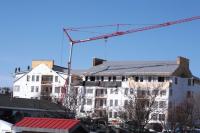Move Over, Sears House
Panelized Construction Becoming A Recognized Technique In Vermont

photo by Mike Cameron New condominium construction as seen looking west from the National Bank of Middlebury Branch Office on Seymore Street. Naylor & Breen Builders crew members can be seen at far left working on the roof of the complex. |
|
Tuesday March 27, 2007
By Ed Barna
These days, new homes are more likely to come on schedule, on budget, and on a truck. Anyone who has been around the Marble Works Complex recently has seen a remarkable example of an up-and-coming technique called panelized construction. The multistory condominium building has risen with remarkable speed, weather willing or not, with the help of a gigantic crane (or perhaps a boom: “A long pole extending from the mast of a derrick to lift or lower cargo.”).
“That lifter”, said Rob Naylor of Naylor & Breen Builders, “has been used to bring into position prebuilt panels, after which they were attached to the frame.” Sometimes Naylor & Breen makes panels in their own fabrication shop, but for something of this size, they went to a Canadian supplier with whom they have worked in the past, he said.
In other parts of Vermont, some companies are getting their panels from a plant that the LaValley building supplies chain has started in Newport, NH.
And New York State is a source: Paul Truax, founder and general manager of Vermont Built, Inc. in Chester, said they have an independent dealer franchise with the Barden system, makers of panels in upstate New York.
Those looking to cut costs often look to the efficiency of panelized building, Truax said. As an example, he shared an article from a newsletter of PATH, the Partnership for Advancing Technology in Housing, which brings together builders and researchers and manufacturers with help from the federal Department of Housing and Urban Development.
That article described how Vermont Built, seeking to erect a model home before winter set in, was able to get the enclosed shell up in eight days by using panels. He said that nationally, “60 percent of the new housing construction is panel construction right now.”
Here it's important to observe that panelized has very strong competitors, particularly in places like Vermont that have traditions of skilled construction.
John Fish, the new manager at the Middlebury division of the Vermont building supplies group r. k. Miles, said they typically sell the materials to manufacture the panels more than the panels themselves. Their main customers continue to be contractors and others associated with home building.
John made a comparison with North-Central Pennsylvania, from which he had come. In that rural area panels have not been widely used at this time. Still, the trend is worth watching, partly because it gets used in high-end housing as well as affordable housing. The McKernon Group in Brandon, known for homes costing up to $1.5 million, uses what are called SIPS, said company founder Jack McKernon. Structurally Integrated Panel Systems are assembled and sheathed in such a way that they form building units-sort of like trusses, those preassembled roof units you see in piles around many partly constructed structures. McKernon said that when walls, for instance, are built horizontally, you can spray urethane foam insulation so it finds and fills every opening, then hardens to the point where it adds structural strength.
McKernon, who said he was involved in the first development of urethane insulation back decades ago, has found that his company can often use two-foot-on-center stud systems thanks to the rigid foam-thus reducing lumber costs and minimizing potential air infiltration points. (We got a chance to try breaking a chunk of the “foam” while covering the construction of the “cow power” generating building at Blue Spruce Farm in Bridport, and concluded it would probably be easier breaking a brick.)
Just to show there's nothing really new, there was a time when you could buy a house from Sears Roebuck and have it delivered, to be put together by a contractor or even by yourself. Radio humorist Jean Shepherd did one of his funniest programs on the time his father got one, and invited his friends over to help assemble it, and what happened when the beer got flowing.
Those who know the breed can recognize these Sears houses, here and there in the Vermont landscape as well as other places.
In Vermont, some covered bridges have benefited from a sort of panelized construction. A man named Ithiel Town figured out that using criss-crossed thick planks cut in a shop, rather than field-hewn heavy timbers, would build a strong bridge.
The planks, all the same size and shape, with precut holes and premade wooden pegs to put them together, would be brought to the bridge site and assembled. Some of those sites were owned by railroads out West, who had to bridge dry gulches where there hadn't been a tree for centuries.
With the town lattice, you could “build it by the mile and cut it by the yard,” people said. It's the most common covered bridge type in Vermont.
Will panelized construction become as prevalent? Sounds like a good subject for one of Middlebury College's panel discussions.
Ed Barna, besides being a 36-year poet and 24-year journalist, is the author of the guidebook “Covered Bridges of Vermont”
|

 Printer Friendly
Printer Friendly

